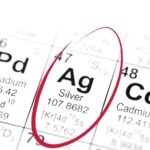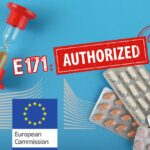
Silver nanoparticles

Silver (nano)particles
By the AVICENN team – Last updated November 2021
How much silver nanoparticules on the market?
Hundreds of tons of silver nanoparticles are produced every year in the world1Some estimates of nanosilver production:
– In 2013, a projection was made for global nanosilver production of between 450 and 542 tonnes for 2014 (The global nanotechnology and nanomaterials industry – Technology Report No. 68 Future Markets, Inc. 2013)
– In 2011, the production of nanosilver was estimated at 20 tons in the United States alone (Estimating production data for five engineered nanomaterials as a basis for exposure assessment, Hendren CH et al, Environ Sci Technol, 45:2562-2569, 2011)
– In 2008, the world production of nanosilver was estimated at 500 tons per year (cf. Mueller NC and Nowack B, Exposure modeling of engineered nanoparticles in the environment, Environmental Science & Technology, 42(12): 4447-4453, June 2008.
From 2013 to 2017, less than 10 kg of nano silver was reported each year as having been produced and/or imported in France in the context of the mandatory reporting. In 2018, the volume of nanosilver reported moved into the 10 to 100 kg range for the first time2Cf. The R-Nano register – The annual declaration of “substances in the nanoparticulate state” in France, mandatory since 2013, veillenanos.fr.
However, there is much more nanosilver in France: this declared “nano-quantity” illustrates the difficulty in apprehending the real quantities of nanomaterials present on French soil via the r-nano register and the annual declaration, the victim of a “filtering effect”.
For what properties?
Silver nanoparticles are mainly used as antibacterial or antifungal agents in the medical and pharmaceutical sector, in packaging (cardboard, plastic) and plastic films, in cosmetics (deodorants, soaps,), in small care appliances (hairbrushes, electric razors, toothbrushes, hair dryers, curling irons, etc.), in textiles (medical staff gowns, fabrics used in operating theatres), on computer and telephone keyboards…
For which products?
Several inventories of products containing nanosilver are available online: they list between 200 and 500 products, but are probably far from being exhaustive, given the low compliance with the labeling obligation.
The few kilos of nano-silver (less than 10) declared to the R-nano register in 2017 were classified in the following categories3Cf. The R-Nano register – The annual declaration of “substances in the nanoparticulate state” in France, mandatory since 2013, veillenanos.fr :
- vehicles
- machines, mechanical devices, electrical/electronic items
- laboratory chemicals
- metals and alloys
- biocidal products (e.g. disinfectants, insecticides)
- use as a laboratory reagent
- production of metal powders (wet process)
- formulation [mix] of preparations and/or repackaging (except alloys)
- general manufacturing, e.g. machines, equipment, vehicles,
- other transport equipment
- scientific research and development
- manufacture of fine chemicals
Silver nanoparticles are present in the food additive E174, a silver colorant used in foods (mainly pastry decorations).
- antibacterial zippered mask pouches, sold with “silver nanoparticles” (and silver nano) (spotted in November 2020).
- Silverloon filter balls loaded with silver nanoparticles, Eurospapoolnews, May 24, 2018: “AELLO introduces its new economical and recyclable filter media for pool sand filters: Silverloon. These filter balls are loaded with silver nanoparticles, giving them bactericidal properties, to limit the development of microbial outbreaks in the pool”.
- silver nanowires for the manufacture of transparent, heating and flexible electrodes, used for anti-icing visors or defogging applications proposed in France in July 2018 by Provatic International (a subsidiary of the Protex International group) following an industrial transfer with CEA Liten.
- silver nanoparticles attached to the surface of textile fibers, to inhibit bacteria and body odor notably in the England jersey worn at the Euro 2004 manufactured by the English sportswear brand Umbro4Tweet from Umbro France, April 2019: “In 2004, Umbro introduced X-STATIC technology in several kits, including the England Euro 2004 shirt, a first. Silver nanoparticles are attached to the surface of the textile fiber, inhibiting bacteria and body odor. #OurGame #Umbro”….
- an Air for life mask presented as “anti-pollution” by British manufacturer Air for Life (AFL), featuring a filtration system containing nano-silver, promoted as being able to remove “99.9% of all indoor and outdoor impurities such as bacteria, dust, pollen, dust mites, viruses, animal dander, PM2.5, smoke, formaldehyde, benzene, other gaseous pollutants and volatile organic compounds (VOCs)”.
Given the risks associated with silver nanoparticles, more and more manufacturers are using the “nano-silver free” claim as a selling point. This is the case of :
- Fisher and Paykelt 5The Invisible Revolution, Sustainability Council of New Zealand, May 2010, p.20.. The company chose to distinguish itself from its competitor Samsung by turning its refusal to integrate silver nanoparticles into its washing machines into a sales argument; the same goes for the company Man & Machine, which promotes its keyboards and mice without nanosilver 6Nanoparticles: a real danger for health and the environment, press release, Man & Machine, Jan. 13. 2012). Today, many household appliances (washing machines, refrigerators in particular) and electronics (cell phone keyboards, computers, mice, etc.) are indeed coated with nanosilver. In both cases, the companies are hoping that their stated concern for human health and the environment will pay off.
- some brands of menstrual panties7Cf. EU biocides law considered a “standstill” by NGOs, Pesticide Action Network (Germany, Europe, UK), Health & Environment Alliance (HEA), and Women in Europe for a Common future (WECF), January 19, 2012.
Non-approval as a biocide of silver “as a nanomaterial”
In August 2021, the decision of non-approval as a biocide of silver “as a nanomaterial” was published in the Official Journal of the European Union (OJEU) for product types 2, 4 and 9.
This decision was taken because of a legal technicality: an industrialist had not applied for the authorization to use nano-silver for biocidal purposes8Indeed, manufacturers sometimes do not file (or withdraw or do not renew) an application for a biocide that does not meet the stricter requirements of the new Biocidal Regulation (or for which they feel the cost will be too high to meet them). – and not because of the (proven) risks of nano silver for health and/or the environment.
What are the risks?
Nanosilver is in the process of being classified at the European level.
Depending on the use, the “benefit-risk” ratio will be different. While it may be positive for strictly circumscribed medical applications (severe burns for example), it is negative in domestic refrigerators9See for example L’analyse coût-bénéfice de l’usage des nanoparticules dans les réfrigérateurs, ICSI, Les Cahiers de la sécurité industrielle, February 2011.
- Ecodesign of new biocidal agents based on bio-inspired silver nanoparticles coating, thesis by Marianne Marchioni, Grenoble Alpes, October 2018
- INERIS, Données technico-économiques sur les substances chimiques en France : Argent et Nano-argent, DRC-14-136881-07002A, 44 p., May 2015
Any questions or comments? This information sheet compiled by AVICENN is intended to be completed and updated. Please feel free to contribute.
Upcoming Nano Agenda

- Scientific conference
- 23rd International conference on Advanced Nanomaterials
- From July 23 to July 25, 2025
- Website: www.advanced-nanomaterials-conference.com

- E-learning program: awareness-raising for personnel who come into contact with nanomaterials during research, formulation, production, maintenance, cleaning, upkeep, etc., as well as safety coordinators or engineers, facility managers, heads of laboratories where nanoparticles are handled.
- Organizers: INSTN Grenoble (CEA)
- On the program:
- 1 – Introduction, definition and characteristics of nanomaterials
- 2 – Toxicity of nanomaterials: the state of knowledge
- 3 – Metrology and characterization of nanomaterials
- 4 – Prevention and protection against nanomaterials in the workplace
- 5 – Quiz: assessment of learning outcomes
- The 2-hour course can be viewed for one month from the date of registration.
- Website: https://instn.cea.fr/…risques-lies-aux-nanomateriaux…

- 10th International Conference on Nanoscience and Technology
- Organized by: Chinese Academy of Sciences and Chinese National Center for Nanoscience and Technology
- Website: http://www.chinanano.org.cn/en/
Sheet originally posted online in May 2018
Notes and references
- 1Some estimates of nanosilver production:
– In 2013, a projection was made for global nanosilver production of between 450 and 542 tonnes for 2014 (The global nanotechnology and nanomaterials industry – Technology Report No. 68 Future Markets, Inc. 2013)
– In 2011, the production of nanosilver was estimated at 20 tons in the United States alone (Estimating production data for five engineered nanomaterials as a basis for exposure assessment, Hendren CH et al, Environ Sci Technol, 45:2562-2569, 2011)
– In 2008, the world production of nanosilver was estimated at 500 tons per year (cf. Mueller NC and Nowack B, Exposure modeling of engineered nanoparticles in the environment, Environmental Science & Technology, 42(12): 4447-4453, June 2008 - 2
- 3
- 4Tweet from Umbro France, April 2019: “In 2004, Umbro introduced X-STATIC technology in several kits, including the England Euro 2004 shirt, a first. Silver nanoparticles are attached to the surface of the textile fiber, inhibiting bacteria and body odor. #OurGame #Umbro”…
- 5The Invisible Revolution, Sustainability Council of New Zealand, May 2010, p.20.
- 6Nanoparticles: a real danger for health and the environment, press release, Man & Machine, Jan. 13. 2012)
- 7Cf. EU biocides law considered a “standstill” by NGOs, Pesticide Action Network (Germany, Europe, UK), Health & Environment Alliance (HEA), and Women in Europe for a Common future (WECF), January 19, 2012
- 8Indeed, manufacturers sometimes do not file (or withdraw or do not renew) an application for a biocide that does not meet the stricter requirements of the new Biocidal Regulation (or for which they feel the cost will be too high to meet them).
- 9See for example L’analyse coût-bénéfice de l’usage des nanoparticules dans les réfrigérateurs, ICSI, Les Cahiers de la sécurité industrielle, February 2011






